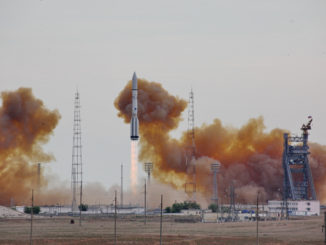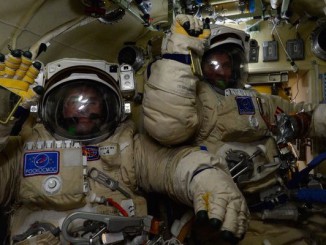STORY WRITTEN FOR CBS NEWS “SPACE PLACE” & USED WITH PERMISSION
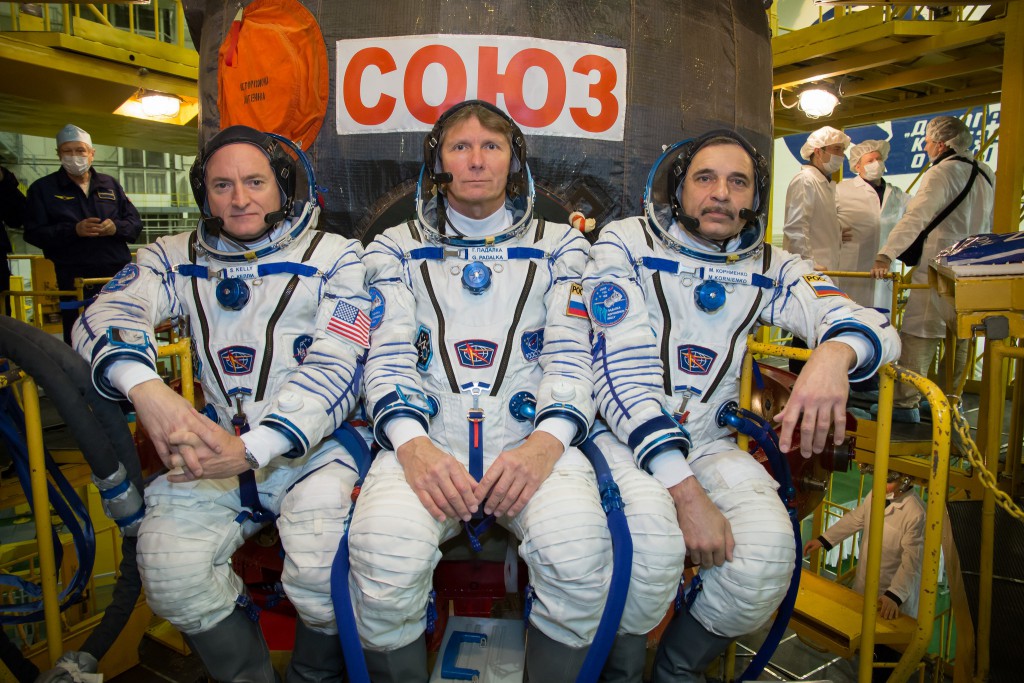
Shuttle veteran Scott Kelly first heard about NASA’s plans to send an astronaut to the International Space Station for nearly a full year shortly after he completed his third space flight in 2011, a 159-day stay aboard the orbital lab complex.
The idea wasn’t particularly attractive.
“At first, I’ll be honest with you, I wasn’t all that interested,” he said. “I hadn’t given it a whole lot of thought, and it was soon after I had gotten back from my last flight. So the difficulty of living and working in space for a long period of time was still kind of fresh in my mind.”
But he thought about it. Then he thought some more.
Finally, after “mulling it over and talking about it with my family, friends, girlfriend, I decided the challenges that staying in space for a whole year presented were appealing to me, even considering the sacrifices you and your family are in for to do that kind of thing.”
In November 2012, Kelly and Russian cosmonaut Mikhail Kornienko, veteran of a 176-day stay aboard the station in 2010, were assigned to what NASA bills as the “One-Year Mission.” Now, after more than two years of training in the United States, Russia, Europe and Japan, they’re finally ready to go.
Joined by Soyuz TMA-16M commander Gennady Padalka, one of Russia’s most experienced cosmonauts, Kelly and Kornienko are scheduled for blastoff from the Baikonur Cosmodrome in Kazakhstan at 3:42:57 p.m. EDT Friday (GMT-4; 1:43 a.m. Saturday local time), departing from the same launch pad used by Yuri Gagarin at the dawn of the space age more than 50 years ago.
If all goes well, the trio will dock at the space station’s upper Poisk module around 9:36 p.m. after a four-orbit, six-hour rendezvous. Standing by to welcome them aboard will be Expedition 43 commander Terry Virts, cosmonaut Alexander Shkaplerov and European Space Agency astronaut Samantha Cristoforetti.
Padalka will return to Earth in September, becoming the world’s most experienced spaceman in the process. Over five missions, he will have logged some 878 days off planet. Kelly and Kornienko will remain aloft until March 3, 2016, logging 342 days in space.
Asked what they will miss the most during their extended stay aboard the station, Kelly and Kornienko both mentioned family and friends, along with Earth’s changing weather.
“As our song says, we dream of the grass by our home,” Kornienko said. “It’s true, that’s what we dream of, the water that doesn’t fly around in bubbles but water you can actually swim in, the forest the fields, that kind of thing.”
Joked Padalka: “I don’t miss anything on Earth, and that’s why I’m flying for a fifth time.”
During the course of the One-Year Mission, Kelly and Kornienko will serve as test subjects for dozens of experiments to measure the long-term effects of weightlessness and to evaluate mitigation measures that will be needed for eventual multi-year missions to Mars.
“If we’re ever going to go beyond low-Earth orbit for longer periods of time, spaceflight presents a lot of challenges to the human body with regard to bone loss, muscle loss, vision issues that we’ve recently realized people are having, the effect on your immune system, the effect of radiation on our bodies,” Kelly said.
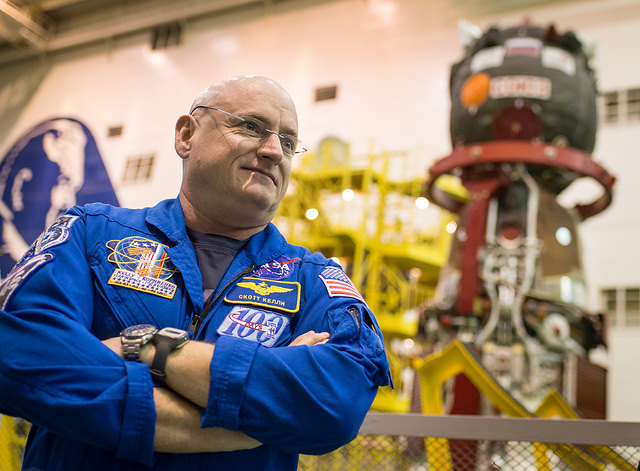
“If a mission to Mars is going to take a three-year round trip, we need to know better how our body and our physiology performs over durations longer than what we’ve previously on the space station investigated, which is six months. Perhaps there’s a cliff out there with regards to some of these issues that we experience and perhaps there aren’t. But we won’t know unless we investigate it.”
Four Russian cosmonauts logged flights lasting between 366 to 438 days aboard the Mir space station — Valery Polyakov, Sergei Avdeyev, Vladimir Titov and Musa Manarov — but the last such flight ended in 1999. Medical technology has advanced since then and an international team of researchers has been assembled to study the results.
“It’s an opportunity to push deeper into space, it’s a stepping stone for that,” Kornienko said. “The last long-term space mission was on the Mir station, and it brought (back) major data for investigations and research about how humans will feel during long term flights into space. I hope that our mission will be an opportunity for others who will follow in our footsteps and take space exploration further.”
Taking advantage of the unique opportunity, Kelly’s twin brother Mark, also a veteran shuttle commander, is participating in control experiments on the ground that will help researchers better understand changes his brother experiences in orbit.
“Because our DNA is so similar, they can look at a lot of this before flight, in flight and after flight and see if there are any like shocking differences between my brother and I that you wouldn’t expect if we were both living here on Earth,” Kelly said. “In other words, they were the result of spaceflight, whether it’s the microgravity environment or radiation, or maybe how our immune systems respond. So it really is a unique opportunity.”
Julie Robinson, NASA’s lead space station program scientist, said the twin studies represent a “unique opportunity.”
“Mark will participate as sort of a ground control to really help us understand this nature-versus-nurture question,” she said. “A group of 10 really premier scientists looking at the genetic basis of disease and the genetic basis of many of the different processes that affect astronauts has partnered in this twin study to really make it a state-of-the-art investigation.”
The Kelly twins and Kornienko will routinely provide samples of blood, urine, feces, saliva, skin cells and mouth swabs “probably over the course of the year almost monthly,” Kelly told CBS News in January. “Today, I actually did my last blood draw (in Houston) and I had a needle in both arms and they took 40 vials of blood from me. So we give a lot of samples, both on the Earth and off the Earth.
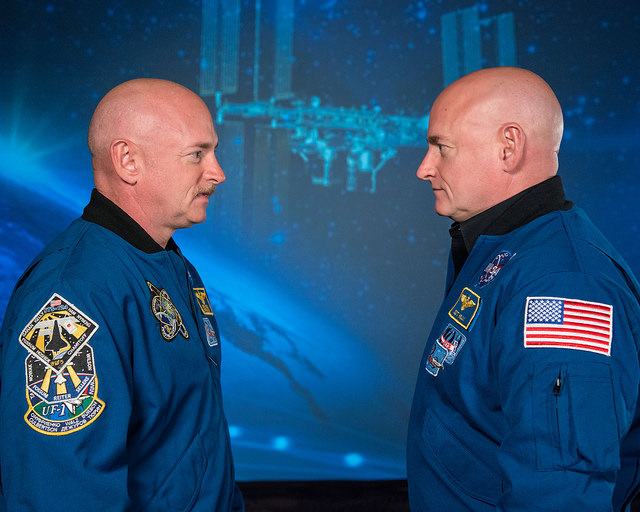
“In addition to that, we do a lot of other medical data takes,” he said. “A lot of them have to do with our vision issues, we do scans with different kinds of devices of our eye and our retina, the optic nerve, we measure with ultrasound various parts of our eye physiology, also our carotid artery, our heart, our leg muscles to look at muscle atrophy.
“There are many, many more, and those are done periodically throughout the mission,” Kelly said. “So probably in the course of any week, I’m probably spending a significant amount of my time doing data collection for the human research, or being the operator for the other crew members we’re collecting data on.”
But the biggest challenge may be psychological. Or as Kelly joked, “it’s not the radiation, it’s the duration.”
While the International Space Station is relatively roomy — the lab’s pressurized volume is roughly equivalent to a 747 jumbo jet — Kelly and Kornienko will still be isolated and out of direct contact with family, friends and co-workers other than station fliers.
“My greatest concern is just missing the people, your loved ones, your family, your friends on a personal level that you’re attached to on the ground,” Kelly said. “Life on the space station is also pretty routine. You know, in the morning you wake up, you’re at work. When you go to sleep, you’re also at work. Imagine being in your office for a whole year and you never get to leave. That is a challenge, it presents its own set of issues, but I think I’m up for it and I look forward to it.”
Throughout the flight, Kelly will participate in an experiment called Journals “where you keep a journal and write down your feelings from a variety of themes. But also on board, we have psychological conferences with our psychological support team every other week. The Russian space agency and the other partner astronauts have a similar program.”
He said he plans to be “completely transparent in my feelings. I’m pretty direct.”
“I think it’s important for all explorers to know what this kind of experience is like, not just within NASA,” he said. “So I plan to be completely honest about it. Now having said that, I haven’t experienced it yet, so who knows, maybe there are some crazy thoughts I’ll have at the end that I wouldn’t want to share. But I wouldn’t suspect that’ll be the case. I think what you see is what you get.”
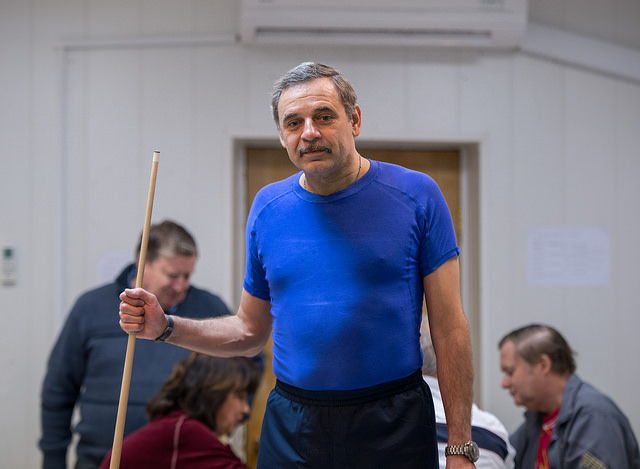
The results of the one-year mission and possible follow-on flights will help researchers design more effective countermeasures to help astronauts cope with the physical and psychological stresses of multi-year missions to Mars or other deep space targets.
A major unknown is whether any potentially serious issues might develop in flights lasting a year or more that don’t show up in shorter six-month missions. Among the questions that must be answered before astronauts take off on multi-year deep space missions:
— What are the effects of space radiation beyond the shelter of Earth’s magnetic field and what can be done to reduce exposure.
— How to maintain muscle tone and bone density in the weightlessness of space to make sure crew members will be able to work unassisted on the surface of Mars. Crew members returning to Earth after six-month station flights can barely walk unassisted even though they typically spend two hours a day exercising.
— How to offset vision problems that can be triggered by fluid shifts in zero gravity that increase pressure in the head, compress the optic nerve and deform the shape of the eyeball.
“In the past 15 years, we’ve really learned a lot about long-duration spaceflight, we’ve learned about the neurological system, the heart, bone, muscle, the immune system, nutrition effects, behavioral effects, radiation effects,” Robinson said.
“And all of those things really affect the bodies of astronauts, and they push them towards something that looks not at all unlike aging on Earth, where their balance is disrupted, their hearts are weaker, their immune system isn’t functioning as well, their muscles are weaker and their bones are being lost.
“And yet, these are healthy people who otherwise would probably be some of the healthiest people back here on Earth for their age. So we care about this, both for future exploration but also because of these potential Earth benefits.”
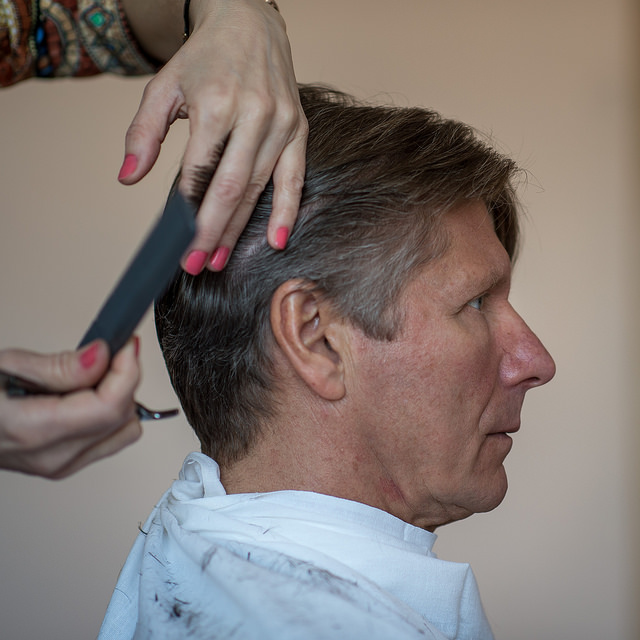
Kelly and Kornienko would face a busy schedule with their research activity alone. But they will be on board the station during the most extensive reconfiguration since shuttle assembly missions ended in 2011.
Seven U.S. spacewalks will be required, three of which were carried out in March, one module will be moved to a different port, a docking port extension will be moved to another module and extensive internal and external wiring modifications will be needed.
The work is required to prepare the space station for dockings by new U.S. commercial crew ferry capsules being built by Boeing and SpaceX. Initial flights are expected in 2017.
While the reconfiguration work is going on, the station crews will carry out a full slate of scientific research with more than 400 investigations in a wide variety of disciplines planned over the next year. And the crews will oversee the arrival and departure of 11 cargo ships — four Russian Progress freighters, five SpaceX Dragons, one Japanese HTV and one Orbital Sciences Cygnus cargo craft.
Along the way, British singer Sarah Brightman will pay a visit, the first space tourist to make a station flight since 2009.
Kelly, Kornienko and Padalka, along with Virts, Shkaplerov and Cristoforetti, will make up the 43rd station expedition. Shkaplerov, Virts and Cristoforetti, who arrived at the lab last December aboard the Soyuz TMA-15M spacecraft, plan to return to Earth May 13, leaving Padalka in command of what will then be the core of the Expedition 44 crew.
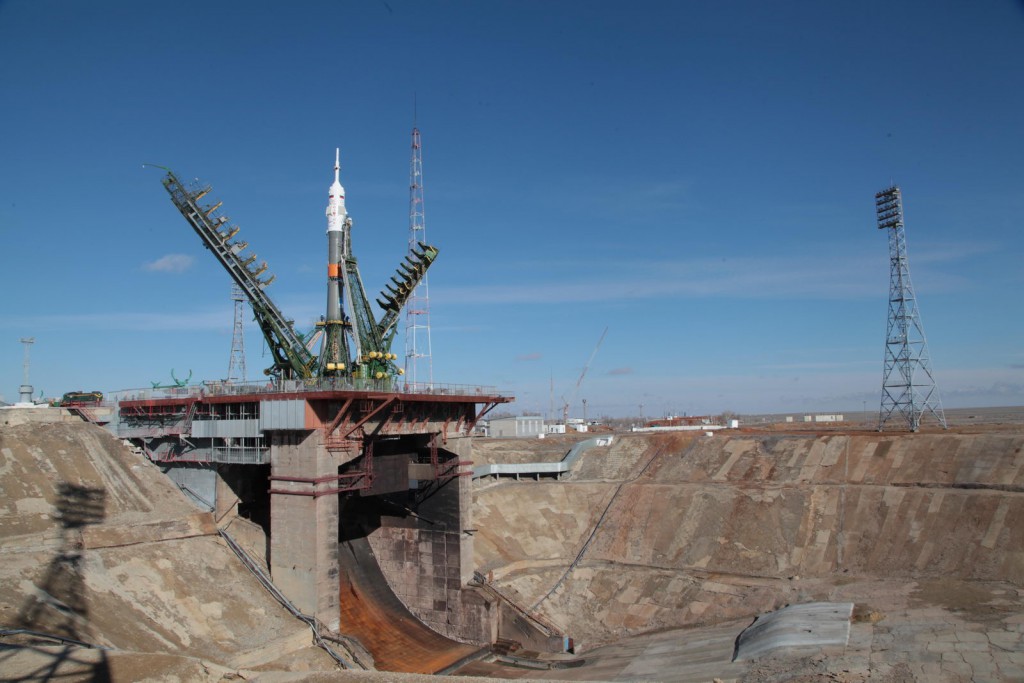
On May 26, three fresh crew members are scheduled to blast off from the Baikonur Cosmodrome aboard the Soyuz TMA-17M spacecraft: commander Oleg Kononenko, NASA physician-astronaut Kjell Lindgren and Japanese astronaut Kimiya Yui.
A few weeks later, the station’s robot arm will be used to detach a storage module known as the Permanent Multipurpose Module, or PMM, from the Earth-facing port of the central Unity module, moving it to the forward port of the nearby Tranquility module. That will free up Unity’s port for future berthings of unpiloted U.S. and Japanese cargo ships.
In July, Kelly and Lindgren will carry out a spacewalk to install an International Docking Adapter, or IDA, that will be mounted on a docking port extension on the front end of the forward Harmony module where space shuttles once docked. The IDA, carried up aboard a SpaceX Dragon cargo ship, can be used by both Boeing and SpaceX crew ships. Power and data cables needed for the IDA were installed during spacewalks in March.
In early August, the station crew will install equipment needed to turn Unity’s Earth-facing port into a berth for cargo ships. If all goes well, a Japanese HTV freighter will use it for the first time later that month.
A few days later, Kelly, Kornienko and Padalka will board their Soyuz TMA-16M spacecraft, undock from the upper Poisk module and re-dock at the aft port of the station’s Zvezda command module.
Normally, three crew members would depart in mid September to be replaced by three fresh astronauts and cosmonauts. But because Kelly and Kornienko are spending nearly a full year aboard the station, they will not be returning to Earth in the normal Soyuz rotation.
Instead, Soyuz TMA-18M will carry a mixed crew to the station Sept. 1 made up of commander Sergei Volkov, Andreas Mogensen of Denmark and Brightman, the 10th space tourist to visit the lab. They will dock at the recently vacated Poisk module. For the next 10 days, the station will host nine crew members, the most since the space shuttle was retired in 2011.
Brightman, Mogensen and Padalka will return to Earth on Sept. 11 aboard the Soyuz TMA-16M spacecraft that carried Kelly, Kornienko and Padalka into orbit. Volkov will remain aboard the station with Kelly, Kornienko, Lindgren, Yui and Kononenko. Kelly will serve as commander of Expeditions 45 and 46.
“I’ve always flown up to space and to the station with great excitement, worked with great enthusiasm. And with equal joy and enthusiasm, I left it,” Padalka joked before launch.
In October, the station’s robot arm will be used to move a docking port extension known as Pressurized Mating Adapter No. 3, or PMA-3, from Tranquility’s outboard port, where it has been in storage, to the port on top of the forward Harmony module.
On Nov. 5, Kononenko, Lindgren and Yui will return to Earth aboard the Soyuz TMA-17M spacecraft and two weeks later, on Nov. 20, Soyuz TMA-18M commander Yuri Malenchenko, British astronaut Timothy Peake and NASA astronaut Timothy Kopra, commander of Expedition 47, will blast off to boost the station’s crew back to six.
Another spacewalk will be needed in December to attach a second IDA to PMA-3 to complete the docking modifications. When all the work is done, Boeing CST-100 crew capsules and SpaceX ferry craft will be able to dock at Harmony’s forward and upper ports while U.S. cargo ships will be able to berth at the Earth-facing ports of Harmony and Unity.
Once the U.S. crew capsules begin flying, NASA plans to boost the station crew to seven, doubling the crew time available for research.
“We refer to that now as the reassembly of the space station,” Kelly said. “The reassembly is there so we can do the science. I’m excited about both of them, the science and the reassembly. I’ve never done a spacewalk, so that’s interesting to me to get to do that. And it’s different, it provides variety.
“When you’re up there that long, if one person was just responsible for the science, that wouldn’t be a good thing. And if one person was responsible for the operations, that wouldn’t be good, either. I think it’s important to share those responsibilities. I look forward to all of it.”
Finally, on March 3, 2016, Soyuz TMA-18M commander Volkov, Kelly and Kornienko will return to Earth, landing in Kazakhstan to close out the year-long mission. Padalka plans to be waiting at the landing site.
“He will be in Baikonur when we land six months after he departs the space station,” Kelly said, “and he says he’s going to carry Misha and I out of the Soyuz like we’re little babies.”

